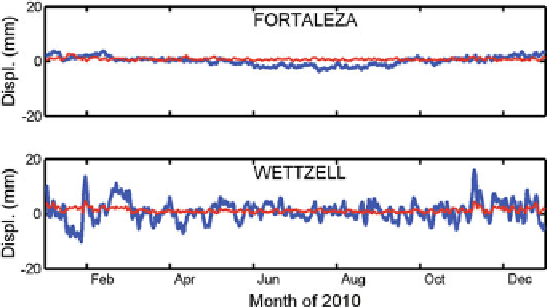Geoscience Reference
In-Depth Information
(a)
(b)
Fig. 6
Non-tidal loading displacements at Fortaleza, Brazil andWettzell, Germany in
vertical
(
blue
)
and
horizontal
(
red
) directions. The horizontal displacements are derived by taking the square-root
of the sum of the squares of the East and North components
Examining Fig.
6
b, we find that peak-to-peak variations in the vertical direction
occur with a period of about 5-12 days which corresponds to the circulations of high
and lowpressure structures inmid-latitude regions, partly due to baroclinic variability
(Dell'Aquila et al.
2005
). These timescales also represent the limit of validity of the
IB assumption for describing the oceanic response to atmospheric pressure forcing.
It is obvious that the displacements contain annual (Fig.
5
a) as well as sub-seasonal
signals (Fig.
6
b), with increasing magnitude during the winter months.
2.1.2 Tidal Loading Displacements
To account for tidal loading displacements, Ponte andRay (
2002
) developed a gridded
global model of
S
1
(
pressure tides using the six-hourly field of the
ECMWF operational analysis. The
S
2
(
p
)
and
S
2
(
p
)
standing wave was propagated by applying
the interpolation procedure proposed by van denDool et al. (
1997
). Comparisonswith
“ground station” tidal estimates at meteorological stations suggest that their model
is reasonably realistic and, thus, it has been recommended in the IERS Conventions
2010 (Petit and Luzum
2010
). However, a large drawback remains, as the resulting
spatial variations of amplitude and phase of atmospheric tides are somewhat too
smooth, especially for the
S
2
(
p
)
tide (Petrov and Boy
2004
). This disadvantage
is due to the interpolation procedure that requires filtering out non-migrating tidal
components.
At Vienna University of Technology, we used the three-hourly pressure level data
from the so-called 'Delayed Cut-off Data Analysis' (DCDA) stream of the ECMWF
over the time period from 2005.0 to 2011.0 with a spatial resolution of 1
◦
.The
'cut-off time' is the latest possible arrival time for meteorological observations to
p
)

